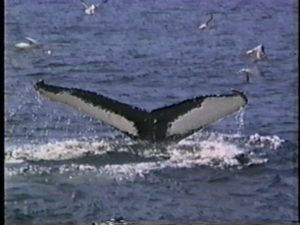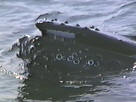Arrow the Humpback Whale
Her Story

Arrow has what I believe is the most beautiful tail of all the whales. For this reason, we selected Arrow to be the mascot and represent the logo for The Whale Video Company. Arrow was first sighted in 1980. Her mother and year of birth are unknown. Sadly, Arrow was last sighted and identified in 1992. While she may still be alive, she may have died at the hands of whalers, become entangled in fishing nets or even struck by a boat. It is likely that we may never know what happened to this most beautiful and awe inspiring humpback whale. We will keep her memory alive in these pages and preserve all the sightings of her in the Whale and Marine Life Video Archives. Click here to see a sample of amazing sights from the archive.
We first adopted Arrow in 1986 before we founded the Whale Video Company. Some people who go whale watching frequently have a chance to see their adopted whale, but many more do not. It can take months or years to see and identify a specific individual humpback whale. I cannot describe my feelings when I first recognized her tail on the water while she was feeding. I am so fortunate to have spent nearly 15 minutes with Arrow that first day. You too can view this magnificent footage below. The extraordinary footage of Arrow feeding on our DVD Salt & Friends: Humpback Whales With Names is the footage I captured that day!
Enjoy this clip of Arrow feeding
The Day I Met Arrow – My Adopted Humpback Whale
Stellwagen Bank is a magical place. It is a National Marine Sanctuary found in the Gulf of Maine, a few miles off the coast of Cape Cod, Massachusetts. For nine months every year, it is the home of animals that can change people forever. Take me for instance.
I started whale watching as a hobby in 1985. I was surprised to learn that the local scientists had named several hundred humpback whales based on marks and scars on their bodies and the underside of their flukes. At the time of my first trip; Salt, Pepper, Midnight and Fringe were favorites of boat owners, naturalists and many local people.
I even adopted a well-known mature female named Arrow. She was the mother of two calves and was named for the scar on her dorsal fin. I picked her from a list of forty because her fluke was absolutely beautiful. It had a unique stream-lined shape and the pattern was a mix of pure black and brilliant white.
Visiting whales where they live was so enjoyable and relaxing that I decided to make a career change from the world of banking to that of recording whale watching trips on videotape.
My efforts would allow whale watchers to share the excitement and emotions stirred by whales with those friends and family at home. The owners of the Dolphin Fleet in Provincetown, MA agreed that this was a valuable endeavor and a handshake (not a written contract) sealed the deal.
We began documenting the trips on April 16, 1988. Nineteen years later, my archives include the sightings from 17,096 individual whale-watching trips. All the behaviors sighted during that time have been saved and tens of thousands of behaviors by named humpback whales have been logged. I have vivid memories from hundreds of trips and thousands of meetings with named humpbacks and the other species frequenting Stellwagen Bank.
One of these meetings was so extraordinary, I can still feel the emotions formed nearly two decades ago. July 23, 1988 started out as one of the most perfect days on the water that summer. The sun was bright, jackets were not required and a barely noticeable breeze left the water flat calm. I was looking forward to the whole day, which would include three whale watch trips and nearly twelve hours on the boat. Every whale watch trip is different and I was anxious to begin recording whatever the whales were doing that day.
Forty minutes after leaving the pier, the naturalist announced that a feeding humpback whale was sighted about two miles from the boat. About ten minutes later we were 200 feet from this 45-50 ton humpback whale. It dove under a large school of sand lance and a minute later we all saw a large circular bubble cloud appear at the surface. This circle of white water and air was at least 50 feet across.
This whale was doing something I had not recorded before; the tip of its flipper would appear slightly above water before you could see the top of its head. It was using its 1000-pound flippers to quickly pull itself up through the school of fish, each sand lance desperately trying to escape the huge open mouth. The humpback whale sometimes breaks the surface with a mouth open so wide it is unbelievable, more than a 90-degree angle.
But this whale was closing its mouth below the surface and then started swimming slowly with just its head above water (this is called dragging). Now its mouth was open just a little to allow the water to flow out through the baleen plates while keeping most of the fish trapped in its lower jaw. I could see a long white mark on the upper jaw and lots of round barnacle scars on the lower jaw. Dozens of sea gulls were circling over the whale and frequently dropped lower to get an injured or stunned fish.
It took forty seconds (I reviewed the videotape) for this whale to squeeze out the water and swallow the fish. The humpback turned slightly to its left, faced away from the boat and prepared to dive again. Experienced whale watchers know that this is the moment when you may see the whale’s fluke or tail pattern.
I could see the blowholes and the whales breath as it was forcefully blown about twenty-five feet into the air. The humpback inhaled and began its dive. Looking down its arching back I noticed the dorsal fin and the large bumps that were parts of the skeletal system. The tail rose slowly into the air, as large as a billboard with water streaming down and the sun creating diamond-like flashes. The top of the tail disappeared in a graceful arch and then the fluke pattern came into view.
This is the moment in time that is seared into my memory.
The monitor on my camcorder was filled with Arrow’s tail pattern! I had just experienced what so few have ever seen. The whale I chose to adopt was beside the boat. This was just the first of many minutes I would spend with her that day.
We stayed with Arrow about fifteen minutes on that first trip and she continued feeding in her unique style. At one point she came so close to the boat while feeding that I could see the individual plates of baleen growing from her upper jaw. In a humorous moment, she even seemed oblivious while dragging when a large sea gull sat on her head for a few seconds.
Arrow stayed in that same area of Stellwagen Bank the whole day. I was fortunate to visit with her again on the other two trips as well. I witnessed a change in her feeding style when she decided to lunge once on her side and later while dragging she had her head, dorsal fin and part of her tailstock above water. This is called snaking but reminds me of pictures of the LockNess monster.
Our archives include footage of more than 500 of the humpback whales that make Stellwagen Bank their summer feeding grounds. I have witnessed spinning head breaches so close to the boats that everyone on the lower deck gets wet. I have seen twenty humpbacks feeding together in a synchronous symphony of movement and grace. I have been blessed by humpback mothers bringing their calves up to and under the boats. But I remember nothing as clearly or fondly, as my meeting with Arrow, the humpback whale.
I saw her a few times in 1989 and 1990. She was last sighted in 1992. No one knows her fate. There is a small hope that she still lives to raise new calves as some whales have returned after nine or ten years.
I am not the only person to be fascinated by whales. In fact, my friend Aaron Avellar should have been immune to their allure. But I believe he loved them even more than I did. You see, Captain Avellar spent decades on the water with them first as a fisherman and later a whale watch Captain. He named Salt, the most sighted and beloved humpback whale in these waters. He was given the honor of naming each of her calves and provided seven names related to the sea and salt. You can learn more about her in the Stellwagen Top 40 area of this website.
I took trips with Aaron where Salt came up to the boats with several of her calves and I know this will sound unreal, but she seemed as thrilled to see him leaning over the boat’s side as he was to see her. Salt is so famous we gave her the title in our first DVD “Salt & Friends: Humpback Whales With Names.” It should surprise no one to learn that it includes Arrow as well.
Arrow and Salt are just two of the more than an estimated 1500 humpback whales in this area. Each one is unique and more than exciting to see in the wild. Perhaps they will play a role in saving themselves and other species from the whaler’s harpoon. Yes, whaling is alive and well.
The whaling nations of the world are continuing their push to once again kill whales in a commercial whaling industry. Japan has announced in 2005 that it will seek to add humpback whales and fin whales to its species list. While the Stellwagen whales are safe from Japan, other populations of humpback whales are more at risk now than in past decades.
Perhaps when enough people learn that whales are individuals with unique personalities, that cameras and camcorders are the only acceptable way to catch whales; there will be a movement once again to save each whale as though it were the last.
If more people could witness just a little of what I have seen, I believe that whaling would end and would exist only in museums and history books.
Arrow‘s History
Arrow‘s Family Tree
| Calves | Year of Birth | Grandcalves |
| Concord | 1985 | |
| Eos | 1987 | None |
| Ascot | 1989 |

Even though her tail is her most outstanding feature, she was named for this mark on her dorsal fin. Unfortunately, Arrow has not been sighted since 1992. There have been whales who have not been seen for ten or more years, that just show up one day. I hope this will happen soon. There is an island nation in the Caribbean that still hunts whales. They kill a mother/calf each spring. I pray that this was not the reason for Arrow’s disappearance.
As you can see below, Arrow is just to beautiful to think that she would be a victim of a cultural event whose time is past.

